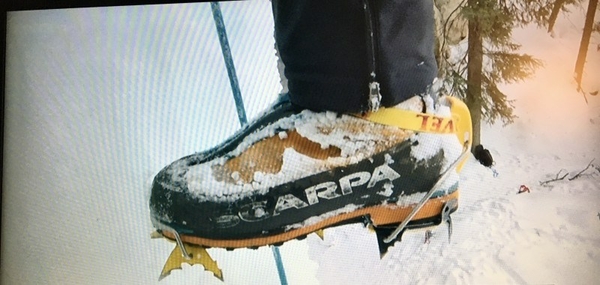(The original Tackety Boot, painted by my sister, Theresa Baker)
Boots were never destined to be the darlings of the catwalk, except perhaps for the sometimes frivolous, rarely practical iterations seen on leggy models. But they do reflect a wide range of uses, some highly specific to certain activities, some merely clumpy, common or garden varieties, and some strongly associated with authority or social rank.
Whatever your needs, you should always consider acquiring footwear that is appropriate to the job, each variation gives an important level of protection. In particular, remember that boots you buy for walking will cover a lot of ground, and make a big difference to your ability and comfort on the trail.
Riding boots, for example, are little use when on foot, but they are obviously tied to horses, (themselves a relatively expensive and little used commodity), in modern times mostly restricted to racing or hunting activities, although some pampered beasts retain a certain status as a ‘pet’ animal. Riding boots would be worn by the local gentry to mark them out as a cut above the pedestrian workers, also by military people of a certain rank. The baddie in war films invariably wears high boots if only as a place to rap their cane or horsewhip !
(A pair of tall field riding boots)
Other boots evolved to meet a particular need, increased safety for example. People who worked on high structures found a need for an inflexible sole, to improve their purchase on some dizzying eyrie – hence rigger’s boots invariably have a steel plate inserted for rigidity. More recently a steel toecap may have been added for those prone to clumsily dropping girders. Mountaineers either copied these plates or initiated the use, because they were able to make safer progress simply by having a toe-hold, the boot itself became a step that you could rely on. When crampons became widely used in ice climbing, you could climb well, just by front-pointing i.e. sticking the front facing spikes into the ice surface and create your own stairway to heaven, or wherever.

My dad always believed you could tell a lot about a person from their footwear, insisting that well kept shoes or boots were a mark of respectability and careful thrift. I guess his childhood poverty emphasised the need to look after the things you had, and put your best face to the world. Everyone instantly recognised the hapless ne’er do well in the frivolous character of Charlie Chaplin’s Tramp. One only has to look at his gap-toed boots to know he’s either badly down on his luck, or a blessed with a serendipitous outlook that made the state of his footwear irrelevant.
(Chaplin in The Little Tramp “Dog’s life © Roy Export SAS)
There are other boots, though, that easily become a part of your day to day life. You’ve probably bought and worn them primarily for hiking trails, maybe mountains, but not necessarily. They’re usually robustly made, whether they are lightweight or not; the current fashion using modern materials is to opt for single skin flexibility and may hardly weigh on your feet at all. Traditional hiking boots used in all seasons were often made double skinned, with a softer inner and a hardwearing outer, waterproofed with oil, wax or grease of some sort and designed to last for many years with diligence and care.
This is when you become attached to your boots most, you’re close up to them, witnessing the tiny scratches or cuts made on your adventures, and working to repair any such damage, or wear and tear, almost as you would care for a sick pet. You will be reliant on them for sure grip, for keeping your extremities dry and hopefully warm, and to support your tentative steps on wobbly terrain and shifting slopes.
A well cared-for pair of working boots – still life by Lilly Mackenzie Hurd ©@findherinthehighlands
After all the excitements of peaks, vistas, woodland and moor, bogs and rivulets and wild camps these unassuming boots have led you through, these faithful servants easily adapt to a quieter but no less useful life near the back door. Patiently waiting like a podgy labrador for an outing in the garden, or a local park. And as time passes, they start to leak and like us, become a bit stiff and creaky, there lies a life yet, sheltering and housing small plants perhaps, or their true hardy character captured in a portrait that seems to honour the miles and years of companionable service they have given.
The Tackety Boot in its final incarnation ♥



Comments (0)